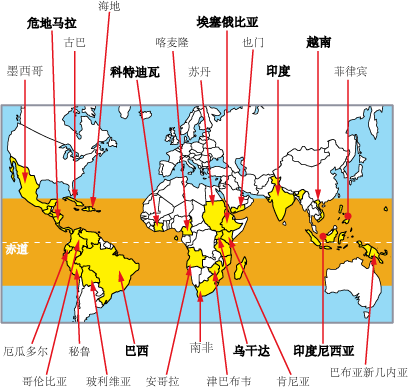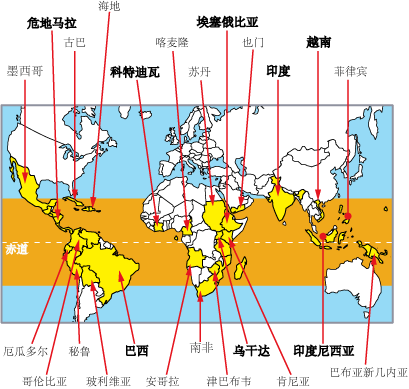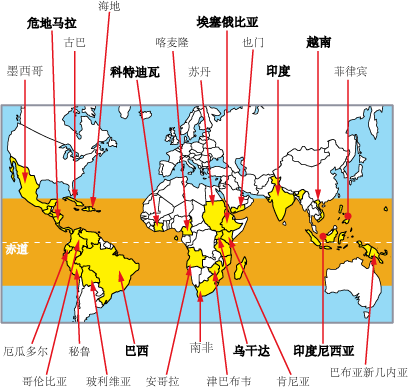The characteristic coffee producer of Arabica beans Papua New Guinea
Papua New Guinea
The legendary background of modern coffee.
In Papua New Guinea, about 75 per cent of coffee products come from small local farms. Many farms reclaim land in the forest, and some are in the depths of the forest, almost isolated from the rest of the world. Coffee in the country is grown on highlands between 1300 and 1800 meters above sea level, so it is of high quality. Although coffee is also grown in some lowlands, the yield is relatively small. Most of the locally grown coffee is grown under natural conditions because of the problems and high costs of transporting fertilizers and pesticides to the farm.
The coffee industry plays an important role in the country's economy. More than 1 million people are directly and indirectly engaged in the industry. The government encourages planting by offering a minimum purchase price. The industry itself is controlled by the Coffee Industry Council (Coffee Industry Board). The commission is located in Goroka, in the eastern part of the island, while exports are handled by private companies.
The frost in 1975 destroyed most coffee crops in Brazil, but stimulated the development of coffee in Papua New Guinea. The Government has implemented a scheme to finance the creation of about 20 hectares of coffee plantations in rural or collective land ownership. This measure has indeed increased the penetration of coffee in the local economy, with annual production reaching 1 million bags by 1990.
However, it is almost inevitable that the surge in production leads to a decline in quality. Before 1991, the quality of coffee was good, and most of it belonged to open Y and so on. After 1991, the quality gradually declined, and with it the European market was lost. The extra price of coffee such as Y also gradually fell. This is related to the country's policy of "one grade, one price". This policy is not feasible for an industry as volatile as coffee. As a result, poor quality coffee beans damaged the image of high quality standards such as Y coffee, resulting in a backlog.
The government's response is to establish a new level of quality, temporarily suspend the production of coffee such as Y, and no longer implement the policy of "one grade, one price". This allows buyers to price according to quality, which is bound to have an impact on the income of farmers who produce shoddy coffee beans. By 1993, the quality problem had been basically solved. Most regular customers are buying coffee from Papua New Guinea again. Coffee such as Y is now sold at a slightly lower extra price, indicating that its quality has improved.
Although coffee trees grow vigorously in some places, the coffee beans harvested vary from raw to ripe due to the lack of persistence of the growers. AA is rare, and you can usually buy An and AB grades. The main characteristics of grade A coffee are: plump particles, light acidity, endless aftertaste after drinking.

Important Notice :
前街咖啡 FrontStreet Coffee has moved to new addredd:
FrontStreet Coffee Address: 315,Donghua East Road,GuangZhou
Tel:020 38364473
- Prev

The characteristic coffee beans of Arabica beans New Caledonia
The lost glory of New Caledonia. New Caledonia (New Caledonia) is a former French colony, with only 10 per cent of the land available for farming, with coffee and corn as its main crops. Missionaries introduced coffee from La Runion in 1860, but by 1987 only 40 tons were produced each year, of which 37 tons were exported, mostly to France. The variety of coffee beans is right and wrong
- Next

Arabica beans Arabica beans specialty coffee Tahiti coffee beans Tahiti
Tahiti coffee from heaven. Tahiti coffee is a blessing, since it is scarce. Tahiti coffee is marketed under the name Tahiti. Arabic coffee (Tahiti Arabica). Tahiti is the largest of the Society Islands, and any coffee exported from it is extremely rare.
Related
- How did the Salvadoran coffee industry develop in Central America?
- What exactly does the golden cup extraction of coffee mean?
- The Origin of Coffee flower
- [2023 Starbucks World Earth Day] there are more meaningful things besides free Starbucks coffee!
- What kind of coffee is there in Spain? 9 Flavors of Spanish Coffee
- Aromatic African coffee| Kenya's coffee culture and historical production area
- Liberica Coffee Bean knowledge: the characteristics of Liberian Coffee beans of the three original species of Coffee beans
- The origin and formula of Spanish latte introduces the taste characteristics of Bombon coffee in Valencia, Spain.
- How to adjust the solution of over-extracted coffee
- What is the tasting period of coffee beans? What is the period of coffee and beans? How should coffee wake up and raise beans?

